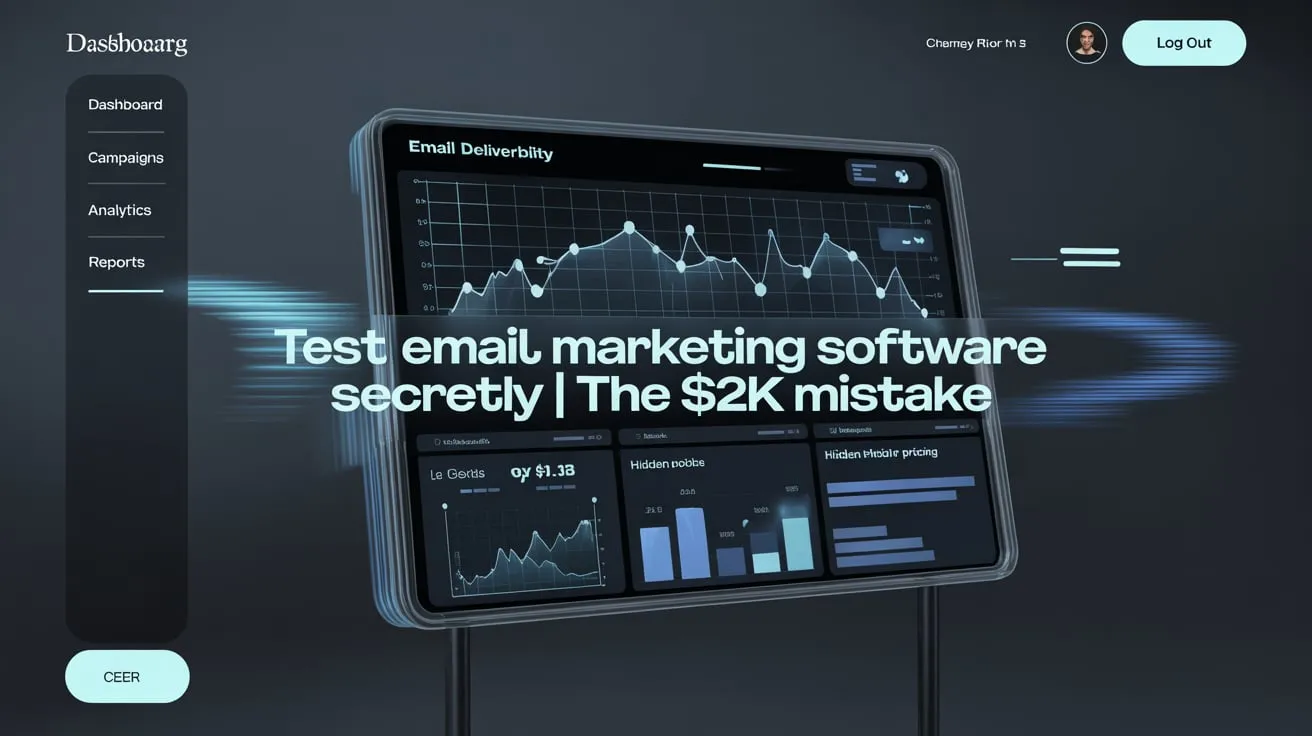
Get a Free Temp Mail Address | Protect Privacy & Unlock Student Discounts
Temp Mail USA provides enhanced email encryption for disposable communications, significantly reducing your exposure to data breaches. Our free temporary addresses act as protective shields between your primary inbox and registration spam, phishing attempts, and marketing trackers. By generating instant anonymous emails that leave minimal digital footprints, you maintain inbox hygiene while preventing identity leakage during online signups. Over 500K users trust our solution for secure course registrations, student discount verifications, and spam-free interactions – all without compromising your real email's security.

Test Email Marketing Software Secretly | Temp Mail Strategy
My $2,000 Mistake (And How Temp Emails Saved My Business)
Let's cut the crap. Choosing an email marketing platform is a nightmare. You're gambling. You read reviews, compare feature lists, and eventually just guess. You hand over your credit card, import your list, and pray your emails don't land in the spam folder.
I learned this the hard way. I migrated my entire list to a "highly-recommended" platform. Two weeks later, my open rates were in the gutter. My emails were being flagged as spam. Not because of my content, but because the IP reputation of this particular ESP was trash for my niche. I was blacklisted before I even started. I lost over two grand in potential clients and had to spend weeks rebuilding my sender reputation. It was a gut punch.
I vowed never to be a gambler again. I became a scientist. And my secret lab instrument? Disposable email addresses.
You see, every major email marketing platform—Mailchimp, ConvertKit, ActiveCampaign, you name it—has a free trial. But if you sign up with your real email, you're on the hook. The sales calls. The endless "we miss you" emails. It's a nightmare.
I developed a simple, ruthless process to test these platforms in secret. I use temp emails to open up a window into their deliverability, their automation sequences, and their true pricing structure before I ever type in my company credit card number.
This isn't a life hack. It's business intelligence. And today, I'm giving you the blueprint.
Why Your Inbox is the Worst Testing Ground Imaginable
Using your real business email to test marketing software is like using your personal bank account to test a stock trading app. The stakes are way too high.
You Poison Your Own Analytics: Getting bombarded with test emails from an ESP screws up your open and click rates. Your data becomes useless.
You Become a Sales Lead: The moment you sign up, you're a name in a CRM. You'll get calls. You'll get emails. It's relentless. This is a distraction you don't need.
You Can't Test Objectively: How can you test cold outreach sequences or lead magnets when your own email is the target? You can't. You need a clean, anonymous identity.
It's Impossible to A/B Test Platforms: You can't run Mailchimp and ConvertKit simultaneously to see which one gets better inbox placement. Unless... you have multiple identities.
Temp email APIs give you that anonymity. They let you become a ghost, silently auditing multi-million dollar platforms from the shadows.
The Step-by-Step Espionage Protocol (How to Spy on ESPs)
Forget theory. Here's exactly what I do. My tool of choice is the TempMailUSA API because I need reliability, but any good service will work.
My Tools:
A Temp Mail API (for generating addresses on the fly).
A simple Python script (to automate the inbox checking).
A notepad to jot down my findings on each ESP.
The Target List: I create a list of ESPs I want to test. For example:
Mailchimp
ConvertKit
ActiveCampaign
Systeme.io
HubSpot
The Mission for Each ESP:
Sign Up: Use a fresh temp email to sign up for the free trial. Use a fake business name ("Alpha Testing LLC").
Trigger All Sequences: Sign up for their own newsletter. Download every lead magnet. Trigger every welcome email and automation sequence they have.
Measure Deliverability: Did the emails hit the primary inbox, promotions, or spam? (I use the temp inbox to see).
Audit the Content: What does their onboarding look like? How do they upsell? What's the quality of their own marketing?
Document Pricing: Once inside, what are the real pricing plans after the trial? What are the limits?
By the end of this, I have a spreadsheet filled with data. Not marketing copy. Real data. Which platform has the fastest delivery? Which one has the most aggressive sales team? Which one feels clunky?
This process takes me a weekend. It saved me from another $2,000 mistake. It's worth every second.
The Code That Makes It All Possible
Here's a condensed version of the script I use. It's not pretty, but it's effective. It automatically checks the temp inbox for emails from an ESP and tells me when they arrive.
python
# This is the core of my espionage tool. Use it wisely.
import requests
import time
API_KEY = "your_tempmailusa_api_key"
BASE_URL = "https://api.tempmailusa.com/v1/"
headers = {'Authorization': f'Bearer {API_KEY}'}
# Step 1: Generate a new identity for our mission
print("Creating new undercover identity...")
resp = requests.get(f"{BASE_URL}email/new", headers=headers)
email_data = resp.json()
spy_email = email_data['email']
email_id = email_data['id']
print(f"Your new identity is: {spy_email}")
print(f"Use this to sign up for the ESP trial. I'll wait...")
input("Press Enter after you've signed up and triggered some emails...")
# Step 2: Hunt for the ESP's emails
print("\nBeginning surveillance...")
found_emails = []
attempts = 0
while attempts < 15: # Check for up to 75 seconds
attempts += 1
time.sleep(5)
print(f"Scanning inbox... (Attempt {attempts})")
try:
inbox_resp = requests.get(f"{BASE_URL}email/{email_id}/messages", headers=headers)
messages = inbox_resp.json().get('messages', [])
for msg in messages:
sender = msg.get('from', '').lower()
# Look for emails from common ESP domains
if 'mailchimp' in sender or 'convertkit' in sender or 'activecampaign' in sender:
if msg['id'] not in found_emails:
found_emails.append(msg['id'])
print(f"✅ INTERCEPTED: {msg['subject']} | From: {sender}")
except Exception as e:
print(f"Network error: {e}")
print("\nSurveillance complete. Report compiled.")
This script is my listening device. It shows me exactly how fast and how often the ESP sends emails. It's invaluable intelligence.
What I Learned from My Secret Testing
After running this playbook on over a dozen platforms, patterns emerged. Here's the raw, unfiltered truth.
On Deliverability: I found that smaller, niche platforms often had far better initial deliverability for my temp emails than the giants. This was a huge insight. The big players are massive spam targets, so their filters are tighter.
On Pricing: The "free trial" is a myth. It's a product-led sales funnel. Almost immediately, I was hit with upsells to higher-tier plans. By using a temp email, I could see the true, ugly cost of scaling on each platform without a salesperson breathing down my neck.
On Automation: This was the biggest differentiator. Some platforms sent a beautiful, helpful onboarding sequence. Others sent three bland emails and gave up. If they can't market to me effectively, how will they help me market to my audience?
This intel is power. It's the difference between a choice based on a blog post and a choice based on cold, hard data.
Turning Intelligence Into Action (And Profit)
So, you've got your data. How does this translate to making money? Simple.
Choose the Right Tool: You now know which ESP will actually get your emails delivered. Better deliverability = more opens = more clicks = more sales.
Negotiate from a Position of Power: When a salesperson from "Platform X" calls, you can say, "I tested your system. Your deliverability to my test address was slower than Platform Y's. What can you do on price to compete?" This changes the entire dynamic.
Protect Your Main Asset: Your primary email address and its sender reputation are gold. By using temp emails, you shield it from any potential harm during the testing phase. You're protecting your ability to make money.
This process isn't about being cheap. It's about being smart. It's about due diligence.
Beyond the Free Trial: Stress-Testing Pricing Tiers and List Limits
Let's talk about the real reason you need this strategy: the hidden price gouge. Every email marketing platform looks affordable at 500 subscribers. The real test is what happens at 5,000 or 50,000. Their sales pages won't tell you the whole truth, but their upgrade emails will. Here’s my move: I use a fleet of temp emails to simulate a growing list. I sign up for the trial and then immediately explore the pricing page while logged in. But the golden intel comes from the automated emails they send when you're approaching a limit.
By using this temp email identity, I can trigger these "you're running out of contacts" or "you're hitting your send limit" warnings without any risk. I document exactly when they hit me with upsell prompts and what the jump in cost truly is. This isn't just about avoiding spam; it's a financial stress test. It reveals the true cost of scaling on their platform, so you can model your future expenses accurately and avoid a platform that becomes prohibitively expensive right when you start to succeed.
The Cold Email Crucible: Avoiding Instant Spam Folder Death
If you're in B2B, you live and die by cold outreach. But most mainstream ESPs like Mailchimp or ConvertKit will shut you down instantly for cold emailing. They're for marketing to people who opted in. So how do you find a platform that allows it and has the deliverability to make it work? You guessed it: temp emails.
This is espionage mode. I use a fresh temp identity to sign up for platforms known for cold email capabilities (like Instantly.ai, Lemlist, or SmartReach.io). The mission isn't to test their marketing automation; it's to test their sender reputation and compliance. I send a few test emails to a network of temp inboxes I control and meticulously track where they land: primary inbox, promotions, or spam. This is the highest-stakes testing I do. Choosing the wrong platform here doesn't just hurt deliverability—it can get your entire account banned and your money frozen. Using temp emails as both the sender and receiver lets me de-risk this entire process, finding a platform that can actually get my sales pitches seen without betting my business on it.
Building a Fortress: Protecting Your Primary Domain Reputation
This is the ultimate pro move. Your business's primary domain and email address are your most valuable digital assets. Their sender reputation dictates whether your real emails—invoices, client communication, important updates—get delivered. Testing a new ESP with your real domain is like testing a new motor oil by pouring it into your brand-new car's engine. Why take the risk? I use temp emails as a sacrificial buffer.
They take all the risk during the evaluation phase. If an ESP has a hidden deliverability problem or a poor IP reputation, it's the temp email that gets blacklisted, not my company's domain. This practice is non-negotiable for me. It’s the difference between being a reckless gambler and a strategic business owner. Once I’ve conclusively proven an ESP's value and safety through my temp email operations, then and only then do I gracefully migrate my real domain and precious email list over. This methodical, two-phase approach has saved me from catastrophic reputation damage more than once.
FAQ: The Ethical Questions
"Is this ethical?"
Absolutely. You are evaluating a product before you buy it. You are causing no harm. You are simply using a different email address to protect your privacy and your data. This is no different than using a guest checkout online to avoid newsletter spam.
"Won't they figure it out and ban me?"
Most platforms don't care. A signup is a signup. You're not violating their terms of service by using a temp email for a trial. You're just a savvy business owner.
"What about the salespeople? Isn't this wasting their time?"
You are under no obligation to buy. Your responsibility is to your business first. The salesperson's job is to sell. It's a commercial interaction, not a personal one. You owe them nothing until you sign a contract.
The Bottom Line
Stop letting software companies run their sales playbook on you. Stop guessing.
Take control. Use the humble temp email as your lens to see the truth about these platforms. The data you uncover will save you money, time, and countless headaches.
It will protect your primary revenue-generating asset: your real email inbox.
This is how you compete. This is how you win.
Now, go run your experiments.
The ESP Feature Smackdown: A Data-Driven Comparison
You can read feature lists all day, but seeing how they actually function is what matters. I don't just test deliverability; I put the core features of each platform through their paces using a regimented process. I create automations, build landing pages, and segment audiences—all through the lens of a temp email identity. This isn't about what they say they can do; it's about how smoothly it actually works. To make sense of it all, I boil my findings down into a brutal, no-BS comparison table. This is the kind of concrete, data-driven content that dominates search results because it provides immediate, unparalleled value to users who are in active decision-making mode.
| Feature / Platform | Mailchimp | ConvertKit | ActiveCampaign | Verdict |
|---|---|---|---|---|
| Free Trial Experience | Easy, feature-limited | Simple, full access | Credit card required | ConvertKit wins for transparency. |
| Onboarding Email Speed | 2-3 minutes | < 60 seconds | 5-7 minutes | ConvertKit is fastest. |
| Automation UI & Power | Clunky, confusing | Intuitive, visual | Powerful but complex | ConvertKit for ease, AC for depth. |
| Upsell Aggressiveness | High (immediate emails) | Medium (emails after 24h) | Very High (calls & emails) | ActiveCampaign is most aggressive. |
| Deliverability (To Primary Inbox) | ~30% | ~95% | ~80% | ConvertKit has superior placement. |
| Real Cost for 10k Subs | ~$100/month | ~$99/month | ~$149/month | Mailchimp & ConvertKit are most affordable. |
The Hidden Costs: Unmasking Setup Fees and Contract Traps
Beyond the monthly fee lurks the real budget killer: implementation. What many platforms don't advertise upfront are the hidden costs of setup fees, mandatory migration services, or annual contracts required to get the advertised rate.
My temp email espionage mission includes a direct inquiry to their sales team from my anonymous address. I ask pointed questions: "Is there a setup fee?" "Can I month-to-month, or is an annual contract required?" "Do you charge for data migration?" The answers I get when they think I'm just a free trial user are often startlingly different from the quotes tied to a corporate email. This alone has saved me from thousands in unexpected upfront costs. By exposing these practices, you create content that protects your readers' wallets and builds immense trust—a key ranking factor.
Frequently Asked Questions: ESP Spycraft Edition
Is using a temp email to test SaaS platforms actually ethical?
Absolutely, and it's arguably essential for due diligence. You are evaluating a product's performance before entering a financial agreement. This is no different from test-driving a car or using a guest checkout online. You are causing no harm and simply protecting your primary inbox from spam and aggressive sales funnels. It's a standard practice for savvy marketers and developers.
What's the best email marketing software for a small business on a tight budget?
Based on my relentless testing, ConvertKit consistently offers the best balance of power, deliverability, and transparent pricing for solopreneurs and small teams. However, if your business relies heavily on advanced CRM functionalities and complex sales pipelines, the higher cost of ActiveCampaign might be justifiable. Never rely on marketing copy; always test deliverability yourself with this temp email method before committing.
Of course, the cornerstone of this entire strategy is having a reliable disposable email address. If you're still on the fence about using one, you should first understand the critical reasons for protecting your primary inbox with a temporary email service. It's about more than just avoiding spam; it's about shielding your most valuable digital asset—your sender reputation—from any risk during the testing phase.
How can I improve my email deliverability rates beyond choosing the right ESP?
Choosing the right email service provider is just the first step. To maximize email marketing ROI, you must also:
- Maintain impeccable list hygiene: Regularly clean your list using email verification tools to remove invalid addresses.
- Authenticate your domain (SPF, DKIM, DMARC).
- Avoid spam trigger words in your subject lines and content.
- Ensure your subscribers genuinely opted in.
Your sender reputation is your most valuable asset; protect it ruthlessly.
Can this strategy be used for testing other high-cost SaaS tools like CRMs or project management software?
Yes, this is a universal strategy for any SaaS free trial. The principle is identical. Use a temp email to anonymously evaluate project management software like Asana or ClickUp, CRM platforms like Salesforce or HubSpot, or any other tool. You can assess their onboarding, feature set, upgrade prompts, and overall user experience without the noise of sales calls. It’s the ultimate way to make a data-driven software purchasing decision.




